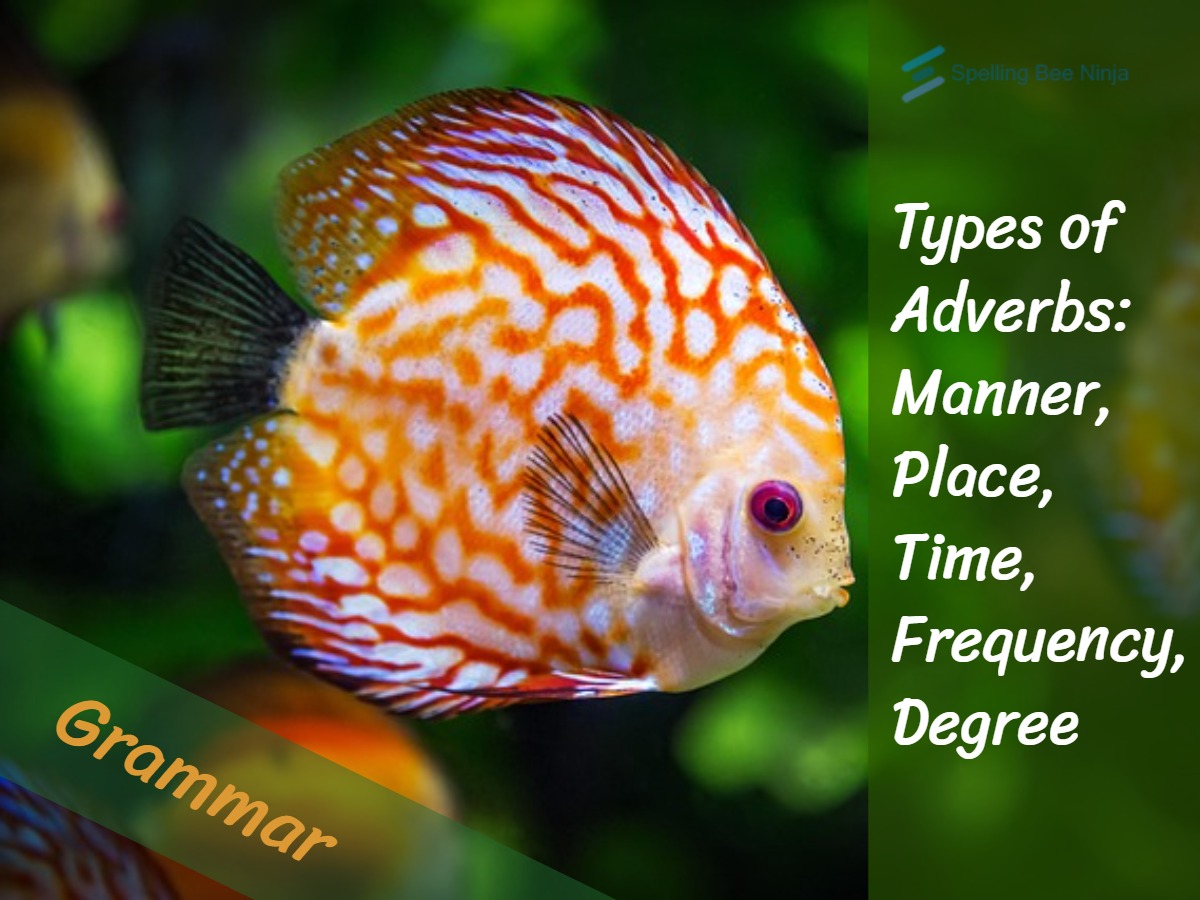Adverbs are essential components of English grammar. They provide extra information about how, when, where, and to what extent something happens. While verbs tell us what is happening, adverbs give us more detail about the action. This makes sentences richer and more informative. In English, adverbs are divided into several categories based on what kind of information they give.
The five main types are adverbs of manner, place, time, frequency, and degree.
Let’s explore each type in detail with definitions, examples, and helpful tips for using them correctly.
Table of Contents
1. Adverbs of Manner
Definition:
Adverbs of manner describe how something happens or is done. They usually answer the question “How?” and are often formed by adding -ly to adjectives.
Examples:
- She speaks softly.
- The dog barked loudly.
- He ran quickly to catch the bus.
- They completed the project efficiently.
Tip:
Place adverbs of manner after the main verb or after the object. For example:
- Correct: She sings beautifully.
- Incorrect: She beautifully sings. (This sounds awkward in most cases.)
Exceptions:
Not all adverbs of manner end in -ly. Words like fast, well, and hard are exceptions:
- He runs fast.
- She did well on the test.
2. Adverbs of Place
Definition:
Adverbs of place tell us where something happens. They answer the question “Where?”
Examples:
- The children are playing outside.
- Please come here.
- The book is upstairs.
- He looked everywhere for his keys.
- Let’s go abroad next summer.
Tip:
These adverbs are usually placed after the verb or after the object:
- She lives nearby.
- We traveled far from home.
Common Adverbs of Place:
here, there, inside, outside, nearby, everywhere, nowhere, above, below, far, near, behind, in front, abroad.
3. Adverbs of Time
Definition:
Adverbs of time tell us when an action occurs. They answer the question “When?” and can also tell us for how long or how often something happens in a given time frame.
Examples:
- He arrived late.
- We’ll leave tomorrow.
- I have seen that movie before.
- She hasn’t called yet.
- They moved here recently.
Tip:
These adverbs can be placed at the beginning or end of a sentence:
- Yesterday, I went to the market.
- I went to the market yesterday.
However, with some adverbs like soon, already, or still, the placement may change depending on the verb tense.
Common Adverbs of Time:
today, yesterday, tomorrow, soon, later, now, then, ago, early, recently, still, yet, already, before.
4. Adverbs of Frequency
Definition:
Adverbs of frequency explain how often an action occurs. They answer the question “How often?”
Examples:
- She always drinks coffee in the morning.
- They usually arrive on time.
- I sometimes skip breakfast.
- He rarely eats junk food.
- We never smoke.
Tip:
For most verbs, place the adverb of frequency before the main verb:
- I often go jogging in the park.
But if the sentence contains an auxiliary verb (e.g., be, have, will), the adverb goes after the auxiliary verb:
- She has always been kind.
- We will never forget this.
Common Adverbs of Frequency:
always, usually, frequently, often, sometimes, occasionally, rarely, seldom, never.
5. Adverbs of Degree
Definition:
Adverbs of degree tell us to what extent or how much something happens. They modify verbs, adjectives, or other adverbs and answer questions like “How much?” or “To what extent?”
Examples:
- She is very happy.
- He completely forgot the meeting.
- The movie was too long.
- They are almost finished.
- I am extremely tired.
Tip:
These adverbs often come before the word they modify, especially with adjectives or other adverbs:
- She is quite talented.
- He spoke too loudly.
With verbs, they can appear before or after, depending on the adverb and sentence structure:
- I completely understand.
- We enjoyed it immensely.
Common Adverbs of Degree:
very, too, quite, almost, nearly, just, enough, hardly, completely, extremely, totally, absolutely, fairly.
Bonus: Identifying Adverbs in Sentences
Here are a few sentences. Try to spot the adverbs and identify their type:
- He rarely visits his grandparents.
- Adverb: rarely (Frequency)
- The cat jumped gracefully onto the bed.
- Adverb: gracefully (Manner)
- We will meet there.
- Adverb: there (Place)
- She left early for the interview.
- Adverb: early (Time)
- I was very surprised by the news.
- Adverb: very (Degree)
✍️ Exercise: Identifying Types of Adverbs in a Short Essay
Instructions:
Read the short essay below carefully. Highlight or underline all the adverbs you can find. Then, identify what type of adverb each one is: Manner, Place, Time, Frequency, or Degree.
📘 Sample Essay: A Day at the Beach
Last Sunday, we visited the beach early in the morning. The sun was already shining brightly, and the waves crashed gently against the shore. We quickly set up our umbrella and towels near the lifeguard tower. My brother enthusiastically ran toward the water, while I slowly walked along the shoreline to collect seashells.
There were people everywhere—some were swimming, others were lying quietly under the sun. I even saw a group of kids building an enormous sandcastle just a few meters away. We usually bring snacks, but we forgot them this time, so we bought ice cream instead. It was extremely hot, and we all got sunburned slightly by the afternoon.
Eventually, we packed up and left the beach. I was completely exhausted, but it was totally worth it. We’ll definitely return next weekend.
🧠 Your Task:
List all the adverbs you found, then classify each into the correct type.
✅ Solution Table
| Adverb | Type | Sentence |
|---|---|---|
| Last Sunday | Time | Last Sunday, we visited the beach early in the morning. |
| Early | Time | We visited the beach early in the morning. |
| Already | Time | The sun was already shining brightly. |
| Brightly | Manner | The sun was already shining brightly. |
| Gently | Manner | The waves crashed gently against the shore. |
| Quickly | Manner | We quickly set up our umbrella and towels. |
| Near | Place | We set up our umbrella and towels near the lifeguard tower. |
| Enthusiastically | Manner | My brother enthusiastically ran toward the water. |
| Slowly | Manner | I slowly walked along the shoreline. |
| Everywhere | Place | There were people everywhere. |
| Quietly | Manner | Others were lying quietly under the sun. |
| Just | Degree | Kids were building a sandcastle just a few meters away. |
| Usually | Frequency | We usually bring snacks. |
| This time | Time | We forgot them this time. |
| Extremely | Degree | It was extremely hot. |
| Slightly | Degree | We all got sunburned slightly by the afternoon. |
| Eventually | Time | Eventually, we packed up and left. |
| Completely | Degree | I was completely exhausted. |
| Totally | Degree | It was totally worth it. |
| Definitely | Degree (or Frequency)* | We’ll definitely return next weekend. |
*Note: “Definitely” can be interpreted as degree (certainty) or frequency (habitual intent), depending on context.
Verification test
Now that you master the knowledge of the 5 types of adverbs, you are ready to take our interactive test to verify you are all set.
Conclusion
Adverbs are powerful tools in English. They add color, clarity, and context to sentences. By mastering the five types of adverbs—manner, place, time, frequency, and degree—you can improve your writing, speaking, and overall comprehension of English.
When learning or teaching English, it helps to practice with each adverb type individually. Try identifying adverbs in your favorite books, news articles, or everyday conversations. Over time, you’ll start using them naturally and accurately.
Remember: Every adverb answers a question. If you can ask how, where, when, how often, or how much, you’re likely dealing with an adverb. Keep practicing, and let your words flow more precisely and effectively!



